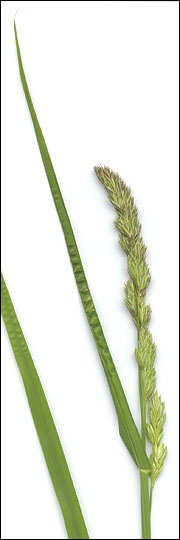Orchard grass
- Dactylis glomerata
Grass
 Good identifiers of orchard grass are its blue-green color and the distinctive shape of its seed head.
Good identifiers of orchard grass are its blue-green color and the distinctive shape of its seed head.
The Samuel Roberts Noble Foundation, Ardmore, Oklahoma
Description
Orchard grass is a cool-season bunch grass that is among the first to begin growth in spring. This exotic grass was introduced from Europe. Its leaves have a bluish cast, and close inspection of the leaf collar reveals a flattened shape and membranous ligule. Seed heads form by late May and are rather distinctive. Height at maturity averages 3 feet.
Use by bobwhites
This introduced grass is among the most wildlife-friendly of the cool-season grasses in the Midwest. Its bunchy growth form allows an open understory, which can result in a diverse plant community when managed with fire or periodic disturbance. Quail nest and brood in stands of orchard grass, especially when it is grown with legumes.
Orchard grass is often ready to cut for hay by the middle of May, when many nests are being constructed. Owners of orchard grass hay fields should plan to leave portions uncut on a rotating basis, or defer hay mowing until early or mid-July. Orchard grass is often planted with annual lespedeza, red clover or alfalfa, which makes it even more attractive to quail. If orchard grass is invaded by tall fescue or smooth brome, it is difficult to eradicate the undesirables without harming the orchard grass.




